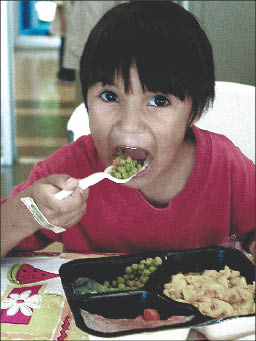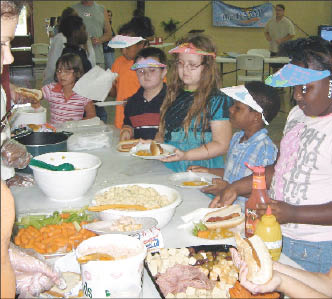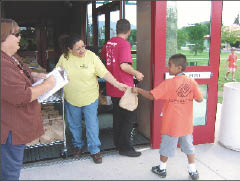Although nearly 19 million children from low-income families eat a free or reduced-priced lunch at school during the school year, according to the U.S. Department of Agriculture, only about 2.2 million children are served each day through the department’s summer food program. At the same time, the recession has increased demand at community food services.
Here are several ways that organizations feed youth outside of school.
Expand Adult Services
Meals on Wheels and More
Austin, Texas
(512) 476-6325
http://www.mealsonwheelsandmore.org
The Strategy: Provide kids in low-income housing nutritious dinners in after-school programs through the apparatus of Meals on Wheels.
 |
|
Dinnertime courtesy of Meals on Wheels. Photo: Meals on Wheels |
Getting Started: Austin’s Meals on Wheels program began in 1972, gradually expanding its adult services to such things as transportation to medical appointments, grocery shopping and home repairs. In 2005, the program started using its existing infrastructure to provide meals to needy youth.
Any adult-services group that wants to expand like this should take note: Andrea Torres, vice president of development for Meals on Wheels and More in Austin, said it can be difficult to attract funders and partners if you want to offer food service to kids and it’s not something you’ve ever done previously or it’s not part of your organization’s mission. “Initially, we had trouble making a case for adding kids’ meals to our mission because we’re known for providing meals to the homebound, elderly and disabled,” she said.
How It Works: Meals for Kids serves eight low-income housing sites that are run by the city’s Housing Authority and the nonprofit Foundation Communities. Two to four days a week, the service delivers meals to the sites’ after-school programs, which are run by Communities in Schools of Central Texas and Heart House Austin, a free after-school program for low-income children.
The youths’ meals are very similar to what’s prepared for adults on the same days. Meals for kids are delivered separately by staffers using Meals on Wheels vans.
Twice a semester, a registered dietician makes a presentation at each site about such issues as healthy snacking, why it’s important to eat fruits and vegetables, and the importance of trying new foods.
Youth Served: About 260 children, ages 6 to 12, across all eight sites on a typical day. Most are Hispanic or African-American; 85 percent are on free or reduced-price lunch programs at school.
In surveys by Meals on Wheels, 55 percent of the youth said they never or only sometimes have dinner in the evening at home. The same percentage reported going to bed hungry, sometimes or always.
Staff: Two staffers from Meals on Wheels and More assist with the Meals for Kids programming, aided by volunteers.
Cost: Meals for Kids operates on an annual budget of $110,000 to $120,000. All funds come from private family foundation grants. Seed money was provided by the Michael & Susan Dell Foundation.
Send Food Home with the Kids
Tri-State Food Bank
Evansville, Ind.
(812) 425-0775
http://www.tristatefoodbank.org
The Strategy: Send selected youths home with backpacks full of food every weekend.
 |
|
In line for hot meals at the Kids Café. Photo: Tri-State Food Bank |
Getting Started: The Tri-State Food Bank has been serving 33 counties in Indiana, Kentucky and Illinois since 1982. After recognizing how many kids within its service region qualified for free or reduced-price lunches under the National School Lunch Program, the food bank set out to address the fact that a lot of those youths were probably not eating well outside of school hours. The Weekend BackPack program started in 2005 and operates in one county.
How It Works: Youths in Vanderburgh County who are deemed at the highest risk of not getting proper nutrition outside of school hours are sent home from school with backpacks full of food on Friday afternoons. Those backpacks have two breakfasts, two lunches, two dinners, and two snacks, and sometimes contain donated books and oral care items. A pilot PiggyBackPack program serves preschoolers.
The food bank relies on social workers at area schools to help determine which youngsters probably have the least access to food at home.
The program is now affiliated with Feed America’s national BackPack program.
Tri-State offers two other food programs for youth: A Kids Café that provides hot meals for youths in after-school programs (in partnership with the Media Ministries’ Dream Center, an after-school provider); and Kids Club, where children plant and harvest vegetables in the food bank’s community garden, which they can eat on site or take home.
Youth Served: The Food Bank provides BackPack meals to about 1,800 children each year, from pre-school to age 17. All are eligible for free or reduced-price school lunches.
Staff: Two of the food bank’s 10 full-time employees are regularly involved in coordinating the youth food programs.
Cost: The average cost of the BackPack program is $240 per child for 52 weekends. Tri-State Executive Director Mary Blair said most of the youth programs’ funding comes from individual donors. One key fundraising vehicle is having individuals sponsor a child in the BackPack program for a year. The food bank also receives funding from the Indiana Department of Education, the Grainger Foundation and the ConAgra Foods Foundation.
Map Where to Find Food
State Department of Health and Senior Services
Jefferson City, Mo.
(573) 751-6400
http://www.dhss.mo.gov/sfsp/ (Click on Interactive Map on left.)
The Strategy: Provide a user-friendly online map with up-to-date information about where children can receive free, nutritional meals during the summer.
Getting Started: The interactive map is new to Missouri’s Summer Food Service Program website. The site originally provided PDF documents with similar information, but those documents were not updated often enough and were not fulfilling the needs of the target families, according to Susan White, assistant chief of the state’s Bureau of Community Food and Nutrition Assistance.
The Department of Health and Senior Services, which oversees that bureau, worked with the Information Technology Services Division to build a user-friendly interactive map. White said the map was created in-house with existing resources, and was modeled on an interactive map created for the Special Supplemental Nutrition Program for Women, Infants and Children of Missouri.
How It Works: Visitors can enter a ZIP code, city or county to find a list of food sites for children.
Organizations that can manage a food service program can apply to be sponsors and run food sites. Organizations on the map include community centers, Boys & Girls Clubs, churches, schools and summer camps. An online application system is linked with the map so that when sites are approved by department staff, they appear on the map.
The state works with social services agencies to inform low-income families and youth about the resource. People can also call the food and nutrition bureau for information about sites in their communities.
Staff: All staffers are responsible for helping to maintain the map, White said.
Money: White said that because the department did not use outside contractors, spending was minimal. The software company it used to power the map is ESRI, which does not charge a license fee for nonprofits. See http://www.arcgis.com/home.
 |
|
Banking on it: A volunteer hands out food at a mobile kitchen. Photo: The Food Bank |
Go Where the Kids Are
The Food Bank of Northern Nevada
McCarran, Nev.
(775) 331-3663
http://www.fbnn.org
The Strategy: Feed at-risk kids outside school hours through mobile kitchens and school pantries.
Getting Started: The Food Bank of Northern Nevada opened in 1981 and serves 80,000 square miles of territory in northern Nevada and in the Sierra Nevada range of northern California. The food bank began offering programs geared to youths in 1991, working with local school districts to provide Summer Food Service. At the time, the food bank’s service area had 19,000 children eligible for free or reduced-price lunches.
How It Works: The Food Bank uses several programs of Feeding America, a national network for getting food to those in need (including the Kids Café, BackPack and Summer Food Service), but adds local twists to expand the scale. For example, the Summer Food Service provides food to 22 locations, some of which are served by five cargo vans that go to parks, youth programs and low-income neighborhoods, mainly in Reno and Washoe County. The vans distribute meals for 15 to 30 minutes at one location, then move on to the next stop.
Also, the Food Bank’s high school Food Pantry program stocks small food pantries at seven high schools. Any student can get an emergency bag of food to take home.
The Washoe County School District provides meals for all of the Food Banks kids’ programs.
Youth Served: The Food Bank serves about 2,000 children annually, said CEO Cherie Jamason. All are eligible for free or reduced-price lunches, and the population is largely Hispanic. While its programs are available to preschool through 12th-grade students, most of the youths are in elementary school.
Staff: Four staffers work specifically with kids’ programs, while several part-timers serve meals and drive vehicles during the summer. Many of these part-time workers are school food service employees who are off during the summer months.
Cost: Together, the youth programs cost $500,000 to $600,000 annually.
Feeding America
Feeding America provides support to its network member food banks by obtaining donations from corporations for distribution to local food banks. Feeding America also obtains grants to help fund its network members and strives to standardize food service programs, like the BackPack Program and Kids Café, nationwide.
It has 200 member organizations and reports that those organizations serve about two million annually. Contact: (800) 771-2303, http://www.feedingamerica.org.
























